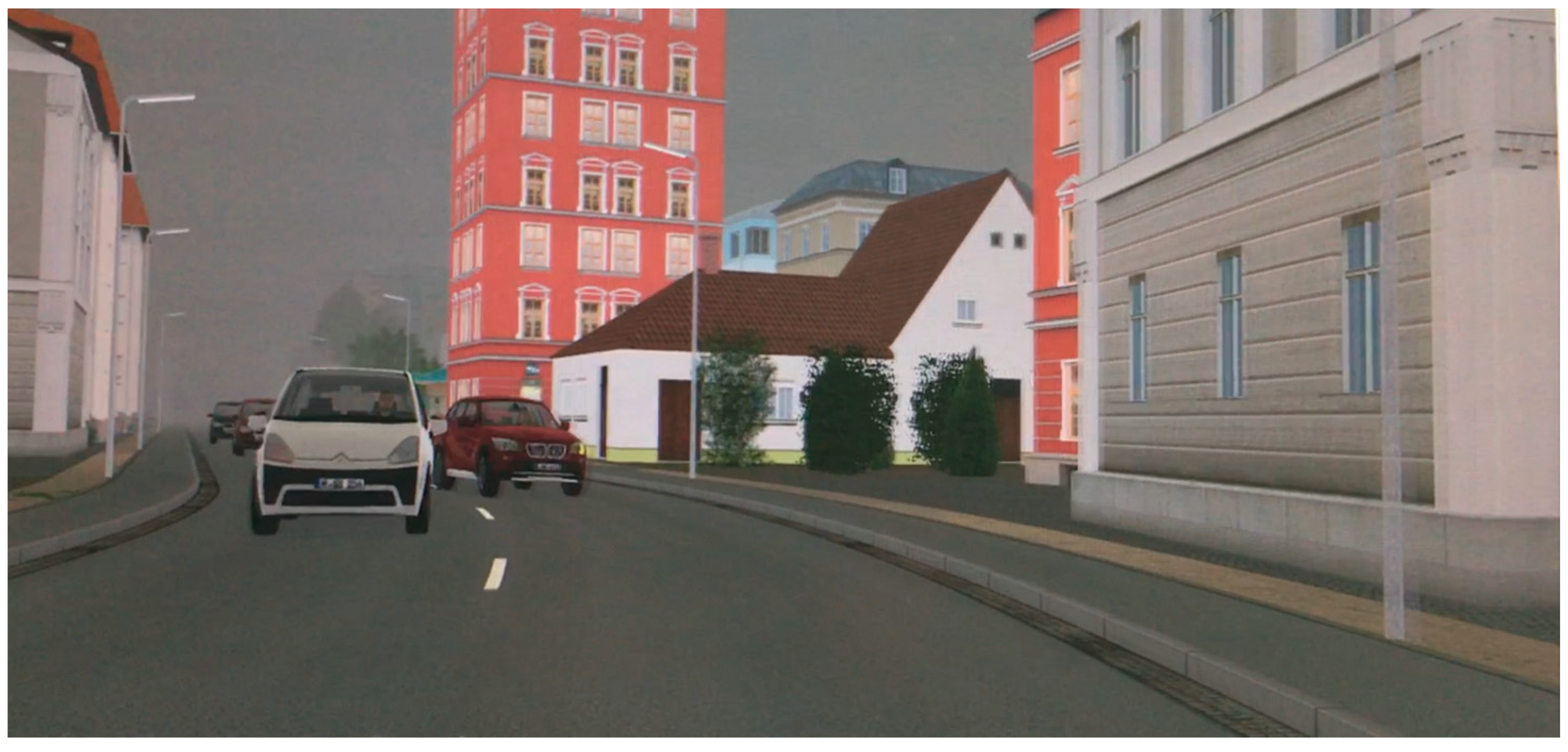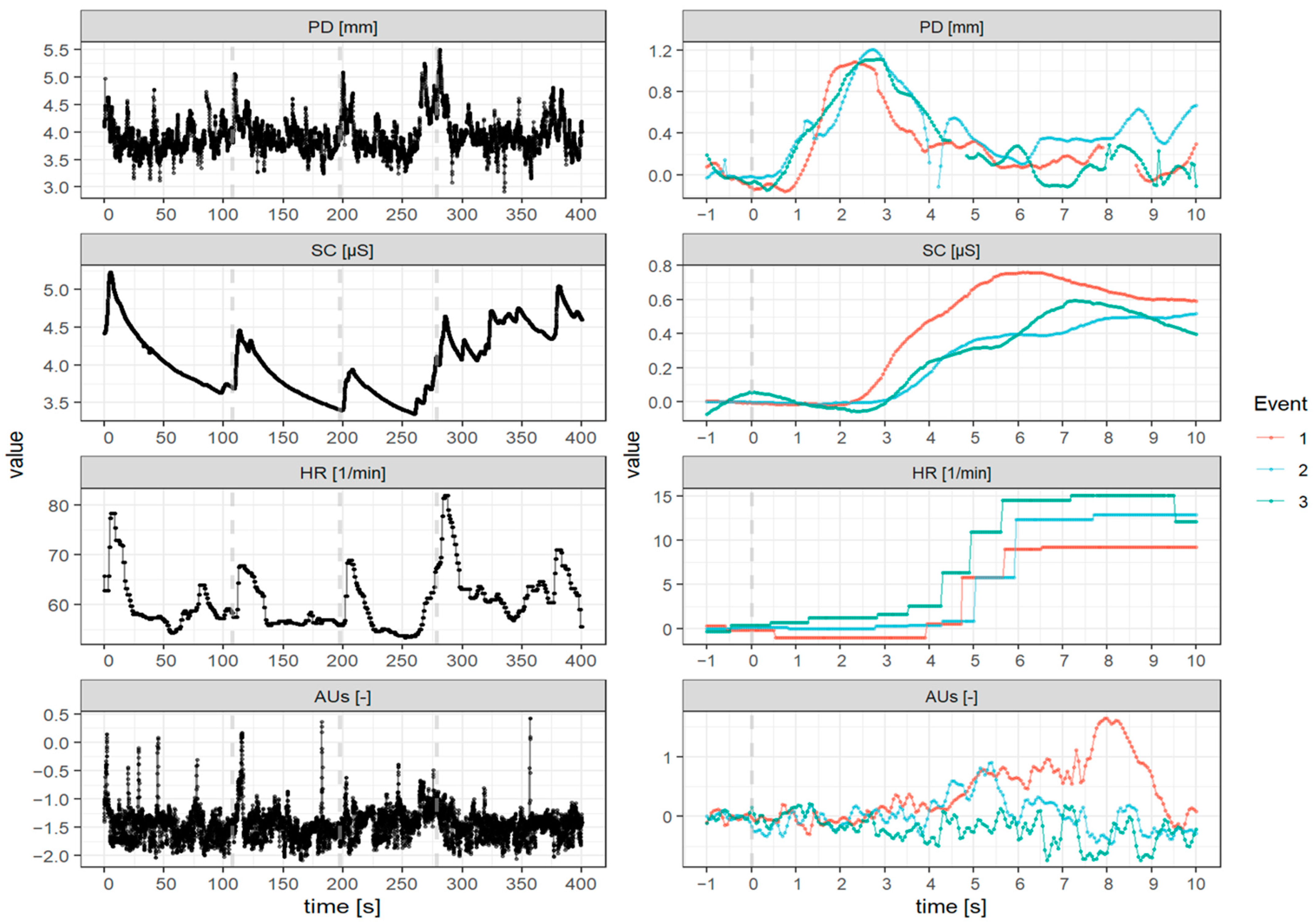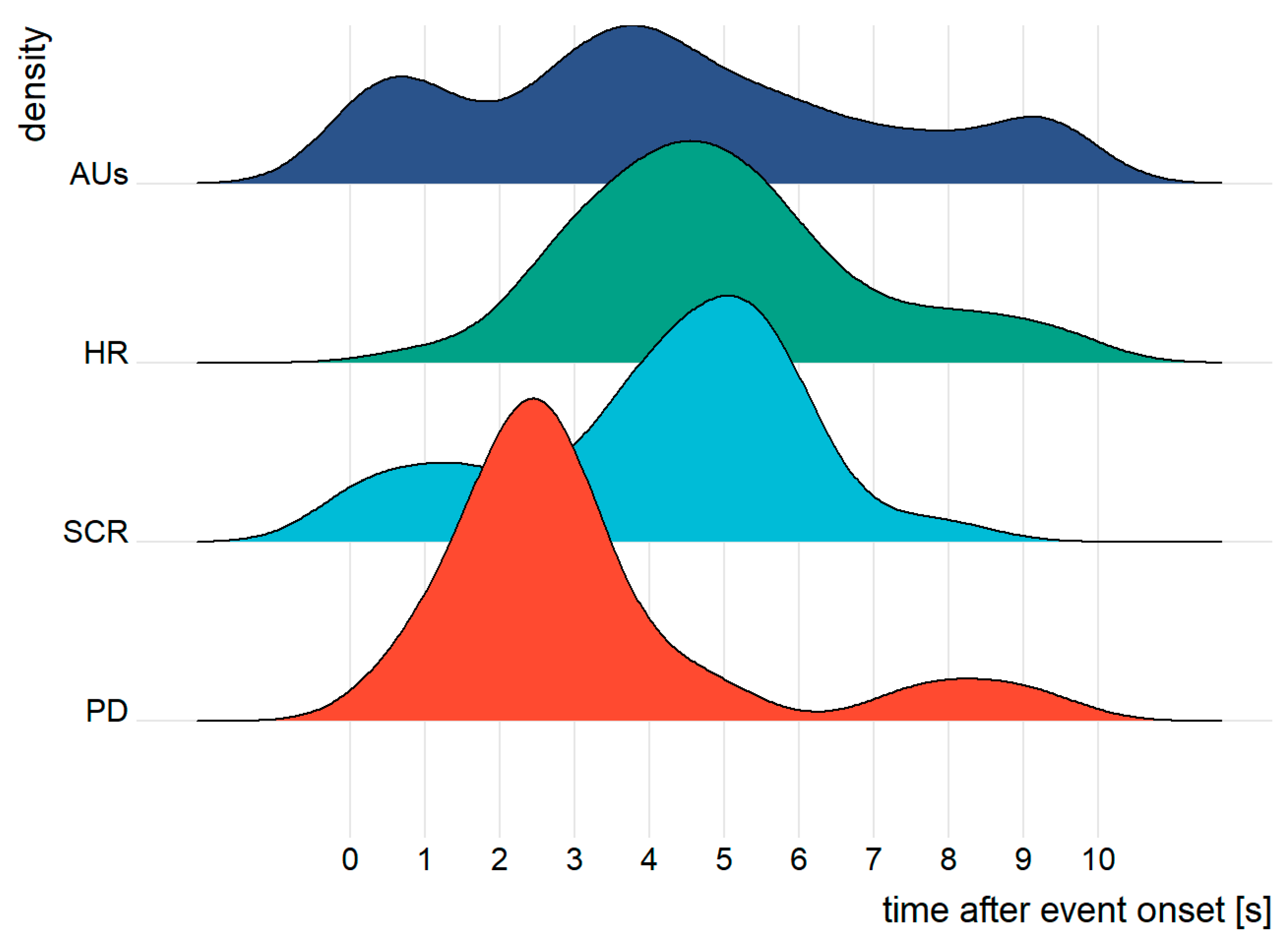The Novelty Appraisal of the Feeling of Risk in Vehicles
Abstract
1. Introduction
2. Methods
2.1. Participants
2.2. Materials and Procedure
2.3. Measurements
2.3.1. Pupil Dilation
- PD changes, quantified as the averaged pupil diameter from event onset to ten seconds after the event subtracted from a baseline (= the mean of the last second before event onset).
- PD amplitude, quantified as the maximum of PD after event onset subtracted from a baseline (= the mean of the last second before event onset).
2.3.2. EDA
- SCL changes, quantified as the averaged SCL from event onset to ten seconds after subtracted from the baseline (= the average of the last second before event onset).
- SCR amplitude, quantified as the amplitude of the first SCR after event onset.
- NSCR, which is the number of SCRs in the ten seconds after event onset.
2.3.3. ECG
- HR changes, quantified as the averaged HR from event onset to ten seconds after subtracted from a baseline (= the mean of the last second before event onset).
- HR amplitude, quantified as the maximum of the HR in the ten seconds after event onset.
- RMSSD, quantified as the square root of the mean of the sum of successive differences between adjacent RR intervals in the ten seconds after event onset.
2.3.4. Facial Behaviors
- AU changes, quantified as the averaged AUs of novelty from event onset to ten seconds after subtracted from a baseline (= the mean of the last second before event onset).
- AU amplitude, quantified as the maximum of AUs of novelty after event onset subtracted from a baseline (= the mean of the last second before event onset).
2.4. Statistical Analyses
2.5. Explorative Analysis of Peak Time
3. Results
3.1. Physiological Responses
3.1.1. Pupil
3.1.2. EDA
3.1.3. ECG
3.2. Facial Behaviors
3.3. Peak Time
4. Discussion
5. Conclusions
Author Contributions
Funding
Institutional Review Board Statement
Informed Consent Statement
Data Availability Statement
Acknowledgments
Conflicts of Interest
References
- Faisal, A.; Kamruzzaman, M.; Yigitcanlar, T.; Currie, G. Understanding Autonomous Vehicles: A Systematic Literature Review on Capability, Impact, Planning and Policy. J. Transp. Land Use 2019, 12, 45–72. [Google Scholar] [CrossRef]
- Summala, H. Risk Control Is Not Risk Adjustment: The Zero-Risk Theory of Driver Behaviour and Its Implications. Ergonomics 1988, 31, 491–506. [Google Scholar] [CrossRef]
- Fuller, R. Towards a General Theory of Driver Behaviour. Accid. Anal. Prev. 2005, 37, 461–472. [Google Scholar] [CrossRef] [PubMed]
- Hoff, K.A.; Bashir, M. Trust in Automation: Integrating Empirical Evidence on Factors That Influence Trust. Hum. Factors 2015, 57, 407–434. [Google Scholar] [CrossRef]
- Drewitz, U.; Ihme, K.; Bahnmüller, C.; Fleischer, T.; La, H.; Pape, A.-A.; Gräfing, D.; Niermann, D.; Trende, A. Towards User-Focused Vehicle Automation: The Architectural Approach of the AutoAkzept Project. In HCI in Mobility, Transport, and Automotive Systems. Automated Driving and In-Vehicle Experience Design, Proceedings of the International Conference on Human-Computer Interaction, Daegu, Korea, 24–26 November 2020; Krömker, H., Ed.; Springer International Publishing: Cham, Switzerland, 2020; pp. 15–30. [Google Scholar]
- Jing, P.; Xu, G.; Chen, Y.; Shi, Y.; Zhan, F. The Determinants behind the Acceptance of Autonomous Vehicles: A Systematic Review. Sustainability 2020, 12, 1719. [Google Scholar] [CrossRef]
- Loewenstein, G.F.; Weber, E.U.; Hsee, C.K.; Welch, N. Risk as Feelings. Psychol. Bull. 2001, 127, 267–286. [Google Scholar] [CrossRef]
- Slovic, P.; Finucane, M.L.; Peters, E.; MacGregor, D.G. Risk as Analysis and Risk as Feelings: Some Thoughts about Affect, Reason, Risk, and Rationality. Risk Anal. 2004, 24, 311–322. [Google Scholar] [CrossRef]
- Taylor, D.H. Drivers’ Galvanic Skin Response and the Risk of Accident. Ergonomics 1964, 7, 439–451. [Google Scholar] [CrossRef]
- Wilde, G.J. Target Risk 3: Risk Homeostasis in Everyday Life; Digital Edition; PDE Publications: Dublin, Ireland, 2014. [Google Scholar]
- Wilde, G. Risk Homeostasis Theory: An Overview. Inj. Prev. J. Int. Soc. Child Adolesc. Inj. Prev. 1998, 4, 89–91. [Google Scholar] [CrossRef]
- Jeon, M.; Walker, B.N. What to Detect?: Analyzing Factor Structures of Affect in Driving Contexts for an Emotion Detection and Regulation System. In Proceedings of the Human Factors and Ergonomics Society Annual Meeting, Las Vegas, NV, USA, 19–23 September 2011; Volume 55, pp. 1889–1893. [Google Scholar] [CrossRef]
- Lu, J.; Xie, X.; Zhang, R. Focusing on Appraisals: How and Why Anger and Fear Influence Driving Risk Perception. J. Saf. Res. 2013, 45, 65–73. [Google Scholar] [CrossRef]
- Schmidt-Daffy, M. Fear and Anxiety While Driving: Differential Impact of Task Demands, Speed and Motivation. Transp. Res. Part F Traffic Psychol. Behav. 2013, 16, 14–28. [Google Scholar] [CrossRef]
- Roidl, E.; Frehse, B.; Höger, R. Emotional States of Drivers and the Impact on Speed, Acceleration and Traffic Violations—A Simulator Study. Accid. Anal. Prev. 2014, 70, 282–292. [Google Scholar] [CrossRef] [PubMed]
- Scherer, K.R. What Are Emotions? And How Can They Be Measured? Soc. Sci. Inf. 2005, 44, 695–729. [Google Scholar] [CrossRef]
- Mesken, J.; Hagenzieker, M.P.; Rothengatter, T.; de Waard, D. Frequency, Determinants, and Consequences of Different Drivers’ Emotions: An on-the-Road Study Using Self-Reports, (Observed) Behaviour, and Physiology. Transp. Res. Part F Traffic Psychol. Behav. 2007, 10, 458–475. [Google Scholar] [CrossRef]
- Schmidt, E.; Decke, R.; Rasshofer, R. Correlation between Subjective Driver State Measures and Psychophysiological and Vehicular Data in Simulated Driving. In Proceedings of the 2016 IEEE Intelligent Vehicles Symposium (IV), Gothenburg, Sweden, 19–26 June 2016; pp. 1380–1385. [Google Scholar]
- Perello-March, J.R.; Burns, C.G.; Birrell, S.A.; Woodman, R.; Elliott, M.T. Physiological Measures of Risk Perception in Highly Automated Driving. IEEE Trans. Intell. Transp. Syst. 2022, 23, 4811–4822. [Google Scholar] [CrossRef]
- He, X.; Stapel, J.; Wang, M.; Happee, R. Modelling Perceived Risk and Trust in Driving Automation Reacting to Merging and Braking Vehicles. Transp. Res. Part F Traffic Psychol. Behav. 2022, 86, 178–195. [Google Scholar] [CrossRef]
- Ekman, P.; Friesen, W.V. Manual for the Facial Action Coding System; Consulting Psychologists Press: Palo Alto, CA, USA, 1978. [Google Scholar]
- Ekman, P.; Friesen, W.V.; Hager, J.C. Facial Action Coding System: The Manual on CD ROM. In A Human Face; Research Nexus: Salt Lake City, UT, USA, 2002; pp. 77–254. [Google Scholar]
- Malta, L.; Miyajima, C.; Kitaoka, N.; Takeda, K. Analysis of Real-World Driver’s Frustration. IEEE Trans. Intell. Transp. Syst. 2011, 12, 109–118. [Google Scholar] [CrossRef]
- Abdic, I.; Fridman, L.; McDuff, D.; Marchi, E.; Reimer, B.; Schuller, B. Driver Frustration Detection from Audio and Video in the Wild; Springer: Klagenfurt, Austria, 2016; Volume 9904, p. 237. [Google Scholar]
- Ihme, K.; Unni, A.; Zhang, M.; Rieger, J.W.; Jipp, M. Recognizing Frustration of Drivers From Face Video Recordings and Brain Activation Measurements With Functional Near-Infrared Spectroscopy. Front. Hum. Neurosci. 2018, 12, 327. [Google Scholar] [CrossRef]
- Grimm, M.; Kroschel, K.; Harris, H.; Nass, C.; Schuller, B.; Rigoll, G.; Moosmayr, T. On the Necessity and Feasibility of Detecting a Driver’s Emotional State While Driving. In Affective Computing and Intelligent Interaction; Paiva, A.C.R., Prada, R., Picard, R.W., Eds.; Springer: Berlin/Heidelberg, Germany, 2007; Volume 4738, pp. 126–138. ISBN 978-3-540-74888-5. [Google Scholar]
- Minhad, K.N.; Hamid, S.; Reaz, M.B.I. A Design Framework for Human Emotion Recognition Using Electocardiogram and Skin Conductance Response Signals. J. Eng. Sci. Technol. 2017, 12, 3102–3119. [Google Scholar]
- Russell, J. A Circumplex Model of Affect. J. Personal. Soc. Psychol. 1980, 39, 1161–1178. [Google Scholar] [CrossRef]
- Russell, J.A.; Barrett, L.F. Core Affect, Prototypical Emotional Episodes, and Other Things Called Emotion: Dissecting the Elephant. J. Personal. Soc. Psychol. 1999, 76, 805. [Google Scholar] [CrossRef]
- Fontaine, J.R.J.; Scherer, K.R.; Roesch, E.B.; Ellsworth, P.C. The World of Emotions Is Not Two-Dimensional. Psychol. Sci. 2007, 18, 1050–1057. [Google Scholar] [CrossRef]
- Gillioz, C.; Fontaine, J.R.J.; Soriano, C.; Scherer, K.R. Mapping Emotion Terms into Affective Space: Further Evidence for a Four-Dimensional Structure. Swiss J. Psychol. 2016, 75, 141–148. [Google Scholar] [CrossRef]
- Zhang, M.; Ihme, K.; Drewitz, U.; Jipp, M. Understanding the Multidimensional and Dynamic Nature of Facial Expressions Based on Indicators for Appraisal Components as Basis for Measuring Drivers’ Fear. Front. Psychol. 2021, 12, 622433. [Google Scholar] [CrossRef] [PubMed]
- Scherer, K.R. On the Nature and Function of Emotion: A Component Process Approach. In Approaches to Emotion; Erlbaum: Hillsdale, NJ, USA, 1984. [Google Scholar]
- Scherer, K.R. The Dynamic Architecture of Emotion: Evidence for the Component Process Model. Cogn. Emot. 2009, 23, 1307–1351. [Google Scholar] [CrossRef]
- Scherer, K.R.; Moors, A. The Emotion Process: Event Appraisal and Component Differentiation. Annu. Rev. Psychol. 2019, 70, 719–745. [Google Scholar] [CrossRef]
- Kozlik, J.; Neumann, R.; Lozo, L. Contrasting Motivational Orientation and Evaluative Coding Accounts: On the Need to Differentiate the Effectors of Approach/Avoidance Responses. Front. Psychol. 2015, 6, 563. [Google Scholar] [CrossRef][Green Version]
- Reisenzein, R.; Horstmann, G.; Schützwohl, A. The Cognitive-Evolutionary Model of Surprise: A Review of the Evidence. Top. Cogn. Sci. 2019, 11, 50–74. [Google Scholar] [CrossRef] [PubMed]
- Scherer, K.R.; Mortillaro, M.; Rotondi, I.; Sergi, I.; Trznadel, S. Appraisal-Driven Facial Actions as Building Blocks for Emotion Inference. J. Personal. Soc. Psychol. 2018, 114, 358–379. [Google Scholar] [CrossRef]
- Mesken, J. Measuring Emotions in Traffic; SWOV Institute for Road Safety Research: Ankara, Turkey, 2002. [Google Scholar]
- Schwartz, G.E.; Weinberger, D.A. Patterns of Emotional Responses to Affective Situations: Relations among Happiness, Sadness, Anger, Fear, Depression, and Anxiety. Motiv. Emot. 1980, 4, 175–191. [Google Scholar] [CrossRef]
- Zhang, T.; Chan, A.H.S. How Appraisals Shape Driver Emotions: A Study from Discrete and Dimensional Emotion Perspectives. Transp. Res. Part F Traffic Psychol. Behav. 2014, 27, 112–123. [Google Scholar] [CrossRef]
- Zhang, M.; Ihme, K.; Drewitz, U. Discriminating Drivers’ Emotions through the Dimension of Power: Evidence from Facial Infrared Thermography and Peripheral Physiological Measurements. Transp. Res. Part F Traffic Psychol. Behav. 2019, 63, 135–143. [Google Scholar] [CrossRef]
- Reisenzein, R.; Bördgen, S.; Holtbernd, T.; Matz, D. Evidence for Strong Dissociation between Emotion and Facial Displays: The Case of Surprise. J. Personal. Soc. Psychol. 2006, 91, 295–315. [Google Scholar] [CrossRef]
- Watson, D.; Clark, L.A.; Tellegen, A. Development and Validation of Brief Measures of Positive and Negative Affect: The PANAS Scales. J. Personal. Soc. Psychol. 1988, 54, 1063. [Google Scholar] [CrossRef]
- Krohne, H.W.; Egloff, B.; Kohlmann, C.-W.; Tausch, A. Untersuchungen Mit Einer Deutschen Version Der “Positive and Negative Affect Schedule” (PANAS). Diagnostica 1996, 42, 139–156. [Google Scholar]
- Makowski, D.; Pham, T.; Lau, Z.J.; Brammer, J.C.; Lespinasse, F.; Pham, H.; Schölzel, C.; Chen, S.H.A. NeuroKit2: A Python Toolbox for Neurophysiological Signal Processing. Behav. Res. 2021, 53, 1689–1696. [Google Scholar] [CrossRef]
- Braithwaite, J.J.; Watson, D.G.; Jones, R.; Rowe, M. A Guide for Analysing Electrodermal Activity (EDA) & Skin Conductance Responses (SCRs) for Psychological Experiments. Psychophysiology 2013, 49, 1017–1034. [Google Scholar]
- Lipponen, J.A.; Tarvainen, M.P. A Robust Algorithm for Heart Rate Variability Time Series Artefact Correction Using Novel Beat Classification. J. Med. Eng. Technol. 2019, 43, 173–181. [Google Scholar] [CrossRef]
- Stekelenburg, J.J.; Boxtel, A. Pericranial Muscular, Respiratory, and Heart Rate Components of the Orienting Response. Psychophysiology 2002, 39, 707–722. [Google Scholar] [CrossRef]
- Bakdash, J.Z.; Marusich, L.R. Repeated Measures Correlation. Front. Psychol. 2017, 8, 456. [Google Scholar] [CrossRef]
- Mangiafico, S. Rcompanion: Functions to Support Extension Education Program Evaluation; R Foundation for Statistical Computing: Vienna, Austria, 2020. [Google Scholar]
- Niepel, M. Independent Manipulation of Stimulus Change and Unexpectedness Dissociates Indices of the Orienting Response. Psychophysiology 2001, 38, 84–91. [Google Scholar] [CrossRef] [PubMed]
- Bradley, M.M.; Cuthbert, B.N.; Lang, P.J. Pictures as Prepulse: Attention and Emotion in Startle Modification. Psychophysiology 1993, 30, 541–545. [Google Scholar] [CrossRef] [PubMed]
- Bradley, M.M.; Miccoli, L.; Escrig, M.A.; Lang, P.J. The Pupil as a Measure of Emotional Arousal and Autonomic Activation. Psychophysiology 2008, 45, 602–607. [Google Scholar] [CrossRef] [PubMed]
- Vrana, S.R.; Cuthbert, B.N.; Lang, P.J. Processing Fearful and Neutral Sentences: Memory and Heart Rate Change. Cogn. Emot. 1989, 3, 179–195. [Google Scholar] [CrossRef]
- Sequeira, H.; Hot, P.; Silvert, L.; Delplanque, S. Electrical Autonomic Correlates of Emotion. Int. J. Psychophysiol. 2009, 71, 50–56. [Google Scholar] [CrossRef]
- Mehu, M.; Scherer, K.R. Emotion Categories and Dimensions in the Facial Communication of Affect: An Integrated Approach. Emotion 2015, 15, 798–811. [Google Scholar] [CrossRef]
- Bujang, M.A.; Baharum, N. Sample Size Guideline for Correlation Analysis. World J. Soc. Sci. Res. 2016, 3, 37. [Google Scholar] [CrossRef]
- Deng, Y.; Chang, L.; Yang, M.; Huo, M.; Zhou, R. Gender Differences in Emotional Response: Inconsistency between Experience and Expressivity. PLoS ONE 2016, 11, e0158666. [Google Scholar] [CrossRef]



| AUs | Description |
|---|---|
| 1 | inner brow raiser |
| 2 | outer brow raiser |
| 4 | brow lowerer |
| 5 | upper lid raiser |
| 7 | lid tightener |
| Parameter | r | df | CI | p | M ± SD in Event | ||
|---|---|---|---|---|---|---|---|
| Event 1 | Event 2 | Event 3 | |||||
| AU changes | −0.52 | 35 | (−0.727, −0.226) | 0.001 *** | 0.06 ± 0.4 | −0.06 ± 0.23 | −0.21 ± 0.27 |
| PD amplitude (mm) | −0.399 | 23 | (−0.697, 0.015) | 0.048 * | 1.14 ± 0.72 | 1.21 ± 0.36 | 0.61 ± 0.37 |
| SCL changes (µS) | −0.393 | 35 | (−0.642, −0.069) | 0.016 * | 0.26 ± 0.29 | 0.18 ± 0.19 | 0.14 ± 0.2 |
| AU amplitude | −0.362 | 35 | (−0.62, −0.032) | 0.028 * | 0.72 ± 0.96 | 0.52 ± 0.23 | 0.31 ± 0.16 |
| HR changes | −0.319 | 35 | (−0.589, 0.016) | 0.055 | 6.62 ± 3.81 | 6.61 ± 4.93 | 4.02 ± 5.29 |
| PD changes (mm) | −0.282 | 23 | (−0.622, 0.148) | 0.172 | 0.28 ± 0.31 | 0.42 ± 0.26 | 0.02 ± 0.35 |
| HR amplitude | −0.174 | 35 | (−0.48, 0.169) | 0.302 | 12.69 ± 5.07 | 13.17 ± 5.97 | 10.85 ± 7.23 |
| SCR amplitude (µS) | −0.109 | 32 | (−0.441, 0.249) | 0.54 | 0.27 ± 0.33 | 0.73 ± 1.57 | 0.3 ± 0.35 |
| RMSSD | −0.094 | 35 | (−0.414, 0.247) | 0.582 | 35.92 ± 18.84 | 40.68 ± 25.32 | 32.82 ± 22.5 |
| NSCR | 0.032 | 35 | (−0.305, 0.361) | 0.851 | 1.44 ± 1.1 | 1.5 ± 1.04 | 1.5 ± 0.99 |
Publisher’s Note: MDPI stays neutral with regard to jurisdictional claims in published maps and institutional affiliations. |
© 2022 by the authors. Licensee MDPI, Basel, Switzerland. This article is an open access article distributed under the terms and conditions of the Creative Commons Attribution (CC BY) license (https://creativecommons.org/licenses/by/4.0/).
Share and Cite
Zhang, M.; Jipp, M.; Ihme, K. The Novelty Appraisal of the Feeling of Risk in Vehicles. Int. J. Environ. Res. Public Health 2022, 19, 14259. https://doi.org/10.3390/ijerph192114259
Zhang M, Jipp M, Ihme K. The Novelty Appraisal of the Feeling of Risk in Vehicles. International Journal of Environmental Research and Public Health. 2022; 19(21):14259. https://doi.org/10.3390/ijerph192114259
Chicago/Turabian StyleZhang, Meng, Meike Jipp, and Klas Ihme. 2022. "The Novelty Appraisal of the Feeling of Risk in Vehicles" International Journal of Environmental Research and Public Health 19, no. 21: 14259. https://doi.org/10.3390/ijerph192114259
APA StyleZhang, M., Jipp, M., & Ihme, K. (2022). The Novelty Appraisal of the Feeling of Risk in Vehicles. International Journal of Environmental Research and Public Health, 19(21), 14259. https://doi.org/10.3390/ijerph192114259







